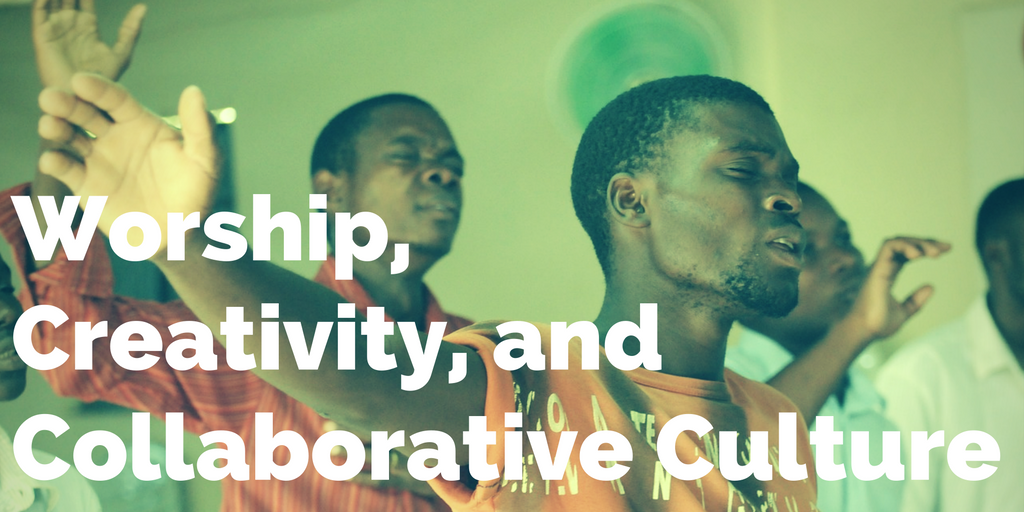We live in a culture that is increasingly being referred to as digital, inventive, participatory, designer, and creative. As a result of this cultural move, people are discovering more about their identities and finding more meaning from what they create rather than what they consume.
The shared language of this culture is one that is filled with potential-based words such as contribution, creativity, making, participation, and collaboration. What this means is participation is assumed in almost everything people care about, contribution is built into almost every experience, and creativity is valued by us more than most of us realize.
The Church, Creativity, and the Collaborative Culture
This seems to raise all kinds of interesting questions for our churches, specifically in relation to how we structure our worship gatherings. How do we design our worship so people become active contributors and not just passive recipients? How do we weave the thread of contribution into the very fabric of our experience? How do we create a time of worship that requires participation in order for the act of worship to be completed?
[Tweet “How do we design our worship so people become active contributors and not just passive recipients?”]
We are realizing that we are emerging out of, yet are still deeply in, a highly consumer-oriented culture. This culture we are transitioning into appears to be one that is highly participatory. We see this high level of participation in social networking sites such as Instagram, Facebook, Twitter, Snapchat, and various blogs.
A central element that is embedded into this participation is the sharing of information, which is a way for people to continuously contribute to the much larger body of information on the Internet. In this culture, people are becoming more concerned with contributing, which can then cause them not to feel connected when they are not contributing to any happenings they are involved with.
We need to be committed to cultivating a community filled with people who see themselves as co-producers of worship as opposed to passive observers who sit back and allow worship to be done for them.
In addition to creating gatherings that invite people to participate in a worship event, we must create space for those people to wholly experience and encounter God, others, and themselves.
Facilitating a Deep Level of Participation
As a result of this necessity, one of our primary goals in our worship gatherings has to be a deep level of participation. Each gathering should provide opportunities for people to actively participate in the creation of worship.
[Tweet “Each gathering should provide opportunities for people to participate in the creation of worship.”]
While each church’s gathering will, of course, be unique, some of the practices our church (Imagine) implements that tend to allow for this deep level of participation are the following practices:
Public reading of biblical texts, prayers, and poems
These help open people up to the part they are called to play in God’s story.
Focused bodily postures
These compel people to engage in a full-body participatory experience.
Creative oral and/or written responses to God before others
These allow people not only to participate in the production of worship, but also to contribute to others’ experiences by providing aids that can deepen those experiences.
5 Deep-Level-Participation Examples
This next list of examples of creative participation in our gatherings is by no means exhaustive, but it may help stoke your imagination to dream of ways that we, as a community, can participate in and contribute to the worship event together. It is a more thorough how-to intended to facilitate deep-level participation.
– Have people write down those parts from their past that they have a hard time accepting as being part of their story. After they have done this, invite them to the Communion table to place those “parts” of their story into a Bible, symbolizing that nothing from their past has to be denied or repressed because everything can be taken in by God and transformed in His story of redemption.
– Have people sculpt bars of soap into intelligible figures to symbolize how God is at work carving away everything within us that gets in the way of our true selves being expressed and seen (this is an exercise I saw in Rob Bell’s “Drops Like Stars”).
– Pass out donuts for people to eat during a sermon in order to experience the difference between knowing and believing, between tasting and thinking.
– Have people write down on name tags a “name” they have been carrying with them (such as unlovable, bad, worthless, invisible, etc.) that is not actually theirs to carry. After they have written on their tags, have each person pass their tag to the person next to them. After sitting with the first name for a minute, have each recipient of a tag write a new name for the giver, a name they sense God may be giving to them. Finally, have them hand the new name tag back.
– Have people write down “Do not cover up what God wants to heal.” on a large Band-Aid and find some place to place it in order to remind them what deep transformation truly is.
We have an exciting opportunity and a spiritual responsibility to find ways to participate in and transcend cognition in order to help people experience God, get in touch with themselves, and make their way into God’s story.
Learn more participatory-worship ideas with a cohort of creative, missional planters!
Share this Post

